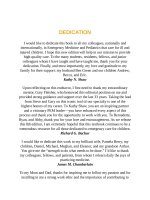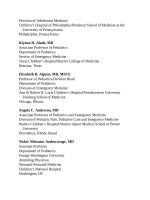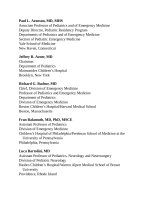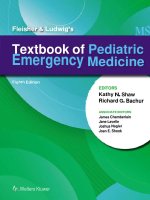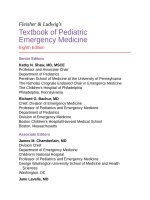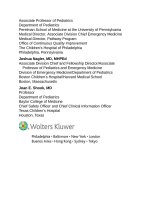Pediatric emergency medicine trisk 0236 0236
Bạn đang xem bản rút gọn của tài liệu. Xem và tải ngay bản đầy đủ của tài liệu tại đây (70.48 KB, 1 trang )
INITIAL STEPS OF NEWBORN RESUSCITATION
Thermoregulation
Ambient temperature in the ED is typically lower than ideal for a newly born
infant whose greater body surface area-to-weight ratio, minimal fat stores, and
thinner epidermal and dermal layers make them particularly vulnerable to
hypothermia. This risk is magnified at lower gestational age and birth weight.
Hypothermia is associated with increased risk of intraventricular hemorrhage
(IVH), respiratory compromise, hypoglycemia, and late-onset sepsis. The
recommended temperature of newly born nonasphyxiated infants is 36.5° to
37.5°C, axillary. Available evidence suggests a dose-dependent increase in
mortality for temperatures below 36.5°C, and simple interventions to prevent
hypothermia in the first 1 to 2 hours of life have been shown to reduce mortality.
The gold standard for warming and maintenance of newborn temperature
remains radiant warmer and hat use. Plastic wrap can be applied to premature
infants <32 weeks’ gestational age to help prevent temperature loss. Other
strategies include increasing the ambient temperature of the resuscitation room,
skin-to-skin contact, warmed blankets, and warmed humidified resuscitation
gases. There is insufficient current evidence to recommend rapid or slow
rewarming of hypothermic newborns. Monitor temperature continuously to avoid
hyperthermia, as this is associated with perinatal respiratory depression and
worsened hypoxic-ischemic injury.
As the patient is dried and placed under a radiant warmer, the temperature
should be monitored via the axillary route using electronic thermometers with a
disposable tip. Rectal (core) temperature measurement is reserved for infants who
are persistently hypothermic.
Stimulation
Most newborns will begin effective spontaneous respirations during stimulation
from routine drying and suctioning. Other methods of safe stimulation include
flicking the heels and rubbing the back of the newborn infant. More vigorous
methods of stimulation are unnecessary and may be associated with harmful
consequences.
Airway
Airway Positioning
During the initial steps of newborn resuscitation, position the infant in a
“sniffing” position, with the neck slightly extended, to open the airway and align

